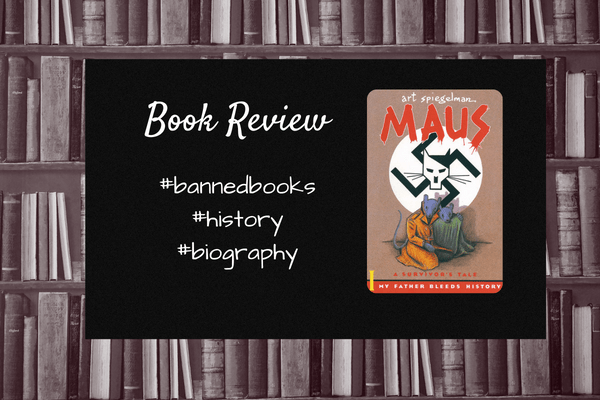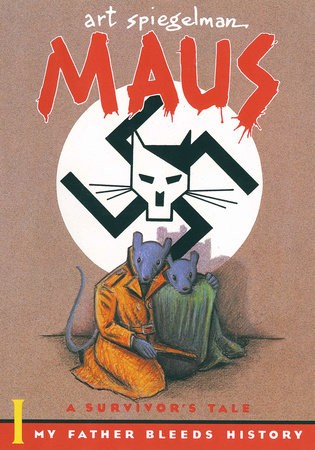A graphic novel about the Holocaust might sound scary. But Art Spiegelman’s story about his father’s experiences during World War II uses mice to portray Jews and cats to portray Nazis. It is a clever way to bring history to life for a new generation of readers. Maus won the Pulitzer Prize in 1992 and has been used in social studies curriculum since the 1990s to teach students about the Holocaust.
But this year, Maus got caught up in the recent increased wave of book bans. Early in 2022, the McMinn County School Board in Tennessee banned Maus from its curriculum and removed Maus from all of its schools. The school board cited nudity, profanity, and violence as reasons for removing the book. So I decided to see what all of the fuss is about.
The Premise
The Wall Street Journal called Maus “the most affecting and successful narrative ever done about the Holocaust.” In Maus, artist Art Spiegelman gives us two compelling stories woven inside each other. The main story belongs to Spiegelman’s father, who suffered in the German occupation of Poland and was eventually sent to Auschwitz. But alongside that tale, Spiegelman tells the story of his difficult relationship with his aging father, who is stubborn and stingy. At one point, the author laments that by portraying his father accurately, he is making his father fit the “racist caricature of a miserly old Jew.” With blunt honestly, Maus tackles the difficulties of this world, from the horror of the concentration camps to the tragedy of aging and fraught family relationships.
What I liked
Maus uses humanoid animal characters and the graphic novel format to brings the Holocaust to life in a real but not frightening way. It describes violent acts, but isn’t explicit. The black and white comic figures are much less disturbing than the graphic images of corpses I saw in the movie Schindler’s List. (The scenes of the Germans moving bodies to be destroyed in the gas ovens literally made me feel faint.) Spiegelman has chosen a clever and non-threatening way to depict an important and terrible time in history. One that we need to remember.
I like how Spiegelman tells his story within the context of his own fraught relationship with his father. He truly struggled to portray a multifaceted person who deserves our sympathy and was also difficult to understand. Suffering in Auschwitz didn’t make his father particularly noble or saint like. He was a flawed human like everyone else. Spiegelman nails this juxtaposition quite well, and forces us all to think about how we must accept people in total, both the good and the difficult.
What I didn’t like
I am not a fan of the graphic novel format. I prefer more prose and deeper insight into character thoughts and motivations. However, I appreciate that for 21st century students and young adults, the graphic novel is an effective way to convey history. I’m surprised more authors aren’t seizing on this genre to tell more about our history.
Should Maus be banned?
No. No book should be. Maus was banned by the Tennessee school district and has been challenged elsewhere for violent content, profanity, and nudity. Spiegelman’s mother Anja committed suicide when Spiegelman was a teen. He depicts the suicide as a comic book within the story, showing his mother (as a mouse) lying naked in a bathtub. There are basic breast shapes with nipples on the mouse character of his mother. But it is a mouse.
There is some profanity. Nazis used profanity with their Jewish prisoners. Spiegelman uses profanity with his father, but it’s not prevalent in the book, and it’s not just there for shock value. When Spiegelman’s character swears at his father for burning diaries from the war, his father reprimands him, saying “even to your friends you shouldn’t talk like this.” Spiegelman’s character later apologizes. The profanity has context.
Maus also depicts the violent treatment of Jews by the cat character Nazis. There is kicking and beating, as well as a panel with characters that have been hanged. But again, they are mice. It’s not graphic. It’s not bloody.
During the board discussion of banning Maus, one member commented that Maus described people being hanged and children being killed. ‘“Why does the educational system promote this kind of stuff?” he asked. “It is not wise or healthy.””
But here’s the thing. Nazis did hang people and kill children. We need to know that. We need to remember that. And Spiegelman presents this truth in an appropriate way for tween and teen readers.
Know what else the Nazis did? They banned and burned books that didn’t conform to the ideology they were pushing. That’s something else to remember.
Recommendation
If you enjoy history, biography, or graphic novels, you should definitely read Maus and the second book in the series, Maus II. And if you believe that books unite us and censorship divides us, you should pay attention to the activity of your local government and school board and do all you can to ensure access to information and civil public discourse.
What banned book have you read and enjoyed lately?
**I wanted to post this during Banned Books Week, but my site was down. However, with the record number of titles being banned these days, it’s always a good time to discuss banned books!
Thanks for getting nerdy with me!



